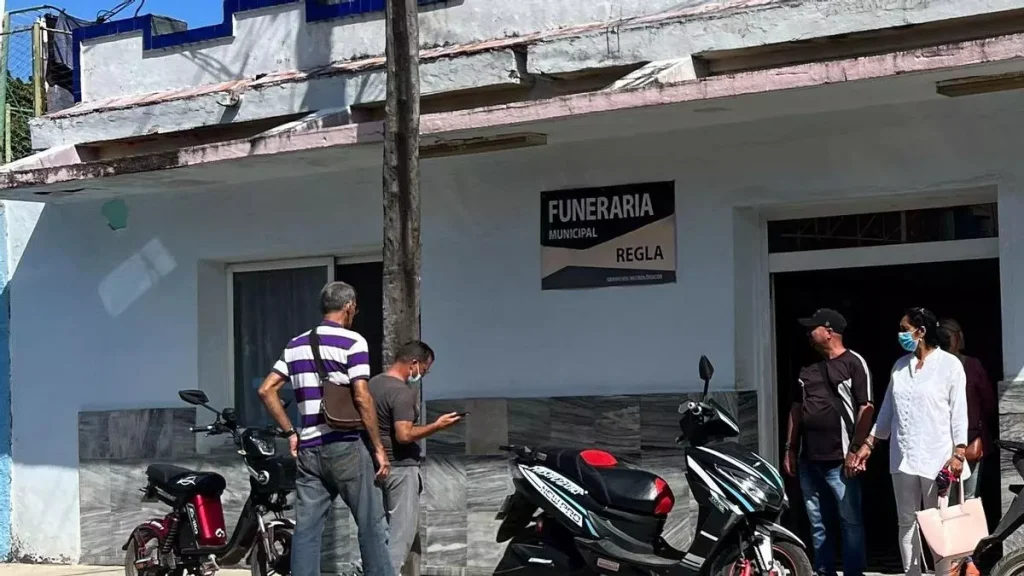The situation is particularly serious in Guantanamo, where there were 27 wakes in a single day

![]() 14ymedio, Dario Hernandez, Havana, November 9, 2025 — In recent weeks, while news programs have been repeating reassuring figures on arboviral cases and hospitals have been avoiding providing complete statistics, funeral homes tell a different story. This newspaper visited several funeral parlors in Havana and observed a pattern that doesn’t fit with the official narrative of “epidemiological control.”
14ymedio, Dario Hernandez, Havana, November 9, 2025 — In recent weeks, while news programs have been repeating reassuring figures on arboviral cases and hospitals have been avoiding providing complete statistics, funeral homes tell a different story. This newspaper visited several funeral parlors in Havana and observed a pattern that doesn’t fit with the official narrative of “epidemiological control.”
In Guanabacoa, the Bertematti funeral home, located between Máximo Gómez and Maceo streets, had all its chapels occupied this Saturday, a rather unusual occurrence for the establishment. Outside, some families waited their turn to secure a space where they could say goodbye to their loved ones.
No one is saying for sure that the deceased were victims of a specific virus. But that is all anyone is talking about. The hushed conversations outside the hospital repeat the same words and phrases: “gelatin,” “soup,” “fevers,” “dehydrated,” “the pain wouldn’t let up.” These are symptoms without a written diagnosis, but the local population has already learned to recognize them immediately.

The same thing happened at the San Miguel del Padrón funeral home. Of the three rooms, two were in use at the time of 14ymedio‘s visit .
At the smaller funeral home in Regla, two rooms were also operating simultaneously this Saturday. In one of them, a doctor could be seen wearing a mask. Her presence there appeared to be part of a health protocol that hasn’t been reported in official media, but which points to a greater emergency than they are admitting.
“Most people don’t go to the hospital. So how do you know how many are sick?” commented the son of one of the deceased, leaning against the wall. Someone close to the family argued that even when a virus is what caused the patient’s fatal decline, it rarely appears as the cause on the death certificate. “If the person had diabetes, heart disease, or asthma, that’s what they put down, not the virus,” they said.
A doctor from Cotorro, consulted by 14ymedio, confirms this with a more technical nuance: “The virus can cause encephalitis and myocarditis, which are indeed listed as direct causes of death. Dengue can cause shock , which is also fatal. But epidemiological statistics are not kept in the emergency room. That is controlled—in theory—in primary care. In practice, the record-keeping is fragmented.”

At the Regla cemetery, a guard sums up the social climate with a phrase that serves as a collective diagnosis: “They see a dead body and immediately think it’s the virus.” This reaction, far from being a sign of epidemiological ignorance, is a fear based on the daily experience of entire neighborhoods being infected, and on the loss of credibility in health authorities.
There were no burials at the crematorium of the New Cemetery of Guanabacoa at the time of the visit, but the workers admit that “the movement has increased” in recent days.
Even those who recover from the viruses circulating unchecked throughout the country suffer long-term aftereffects. Yolanda, 22, fell ill a month ago and has yet to fully recover. “I still have dizziness, persistent pain, and exhaustion,” she tells this newspaper, adding that she still needs physical therapy and rheumatology appointments. “I thought I wouldn’t make it to dawn,” she says. She is the mother of a young child, and at the daycare center, she says there is “panic” because families perceive that the symptoms are more severe in children.

In the La Jata neighborhood, the death of a child has shaken the community. It is the only death that residents attribute without a doubt to the virus. There has been no official statement, but the local memory remains.
In the eastern provinces, the situation is much worse than in Havana. A resident of Guantánamo confirmed that the local funeral home recorded 27 deaths in a single day. He didn’t offer an exact date, only the context: “After Tropical Storm Melissa, everything was turned upside down. Piles of garbage, lack of hygiene, a terrible environment.” The number, local sources say, far exceeded the ordinary perception of mortality. “The whole city is talking about it. People are scared,” he stated.
The situation in hospitals and funeral homes across the country is clear: unsanitary conditions, increased infections, distrust in health institutions, and reluctance to go to hospitals for fear of not being able to leave. The virus—whether dengue, chikungunya, hepatitis, or a mixed case—is a social trigger of panic.
____________
COLLABORATE WITH OUR WORK: The 14ymedio team is committed to practicing serious journalism that reflects Cuba’s reality in all its depth. Thank you for joining us on this long journey. We invite you to continue supporting us by becoming a member of 14ymedio now. Together we can continue transforming journalism in Cuba.
